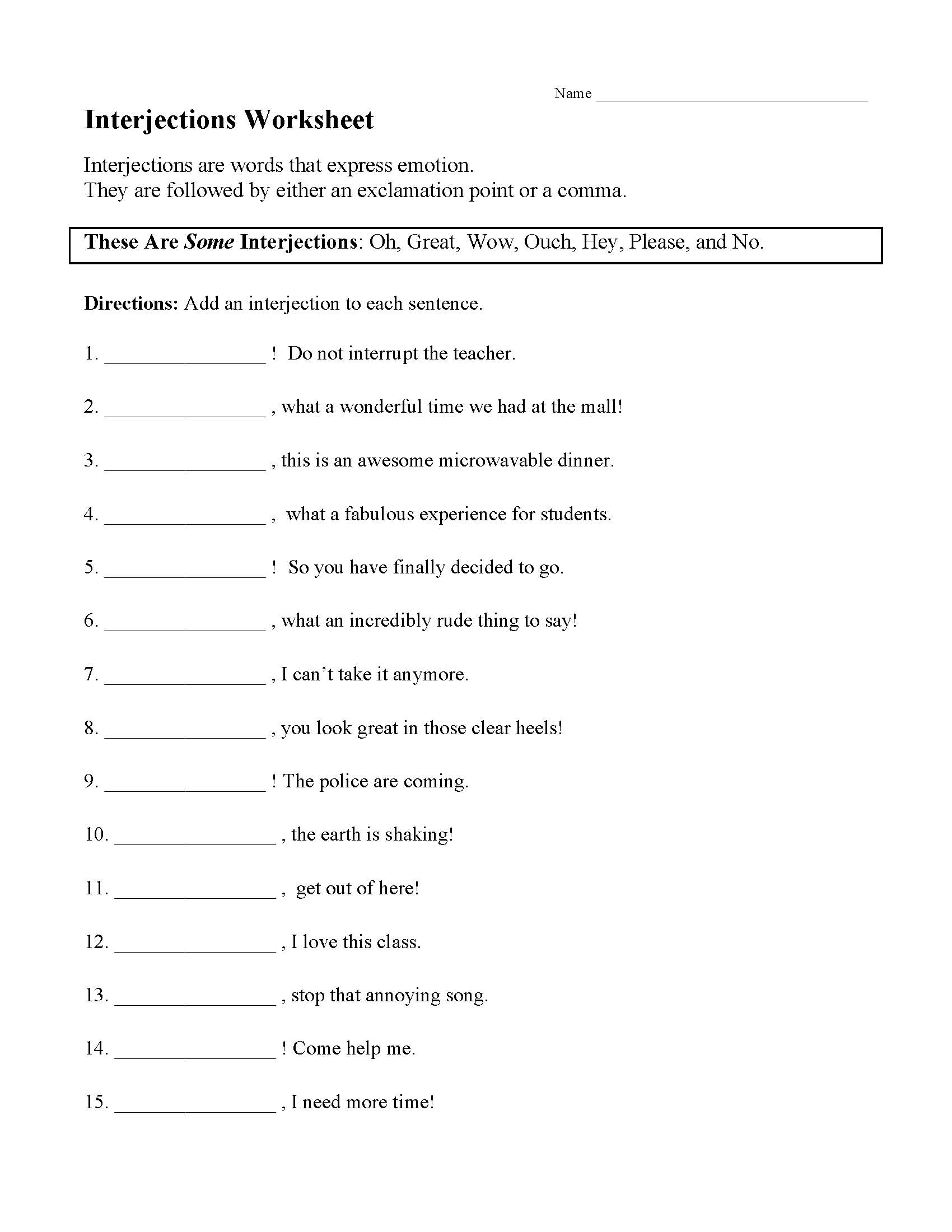
Mastering Emotional Expression: The Power of Interjections Worksheets
Language, at its core, is a tool for communication, and a significant part of effective communication lies in expressing and understanding emotions. While nouns, verbs, and adjectives form the structural backbone of sentences, it’s the humble interjection that truly adds color, immediacy, and a raw sense of human feeling to our words. These often-overlooked linguistic elements are the spontaneous bursts that convey surprise, joy, pain, annoyance, or excitement in a single utterance. For learners and seasoned speakers alike, grasping the nuances of interjections is crucial for both expressive writing and natural conversation. This is where interjections worksheets emerge as an indispensable resource.
This article will delve deep into the world of interjections, exploring their significance, the unique challenges they pose for learners, and how well-designed interjections worksheets can provide a structured, engaging, and highly effective pathway to mastery. We will examine the various types of worksheets available, discuss strategies for their optimal use, and highlight why these seemingly simple exercises are fundamental to achieving fluency and authentic expression in English.

What Are Interjections? The Emotional Outbursts of Language

Before diving into the worksheets, let’s firmly establish what interjections are. An interjection is a word or phrase that expresses an emotion or sentiment. It typically stands alone, or is grammatically independent of the rest of the sentence, acting as a sudden exclamation. Unlike other parts of speech, interjections don’t usually have a grammatical connection to the main clause of a sentence. They simply are.
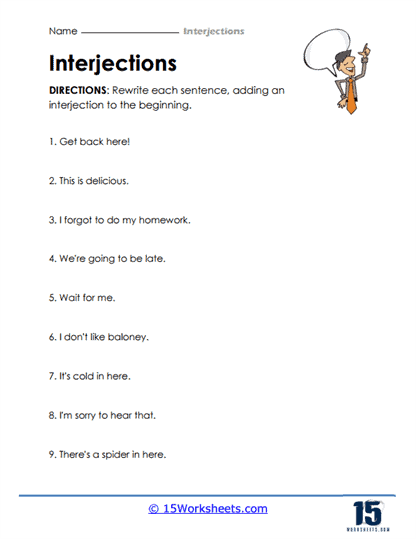
Consider these examples:
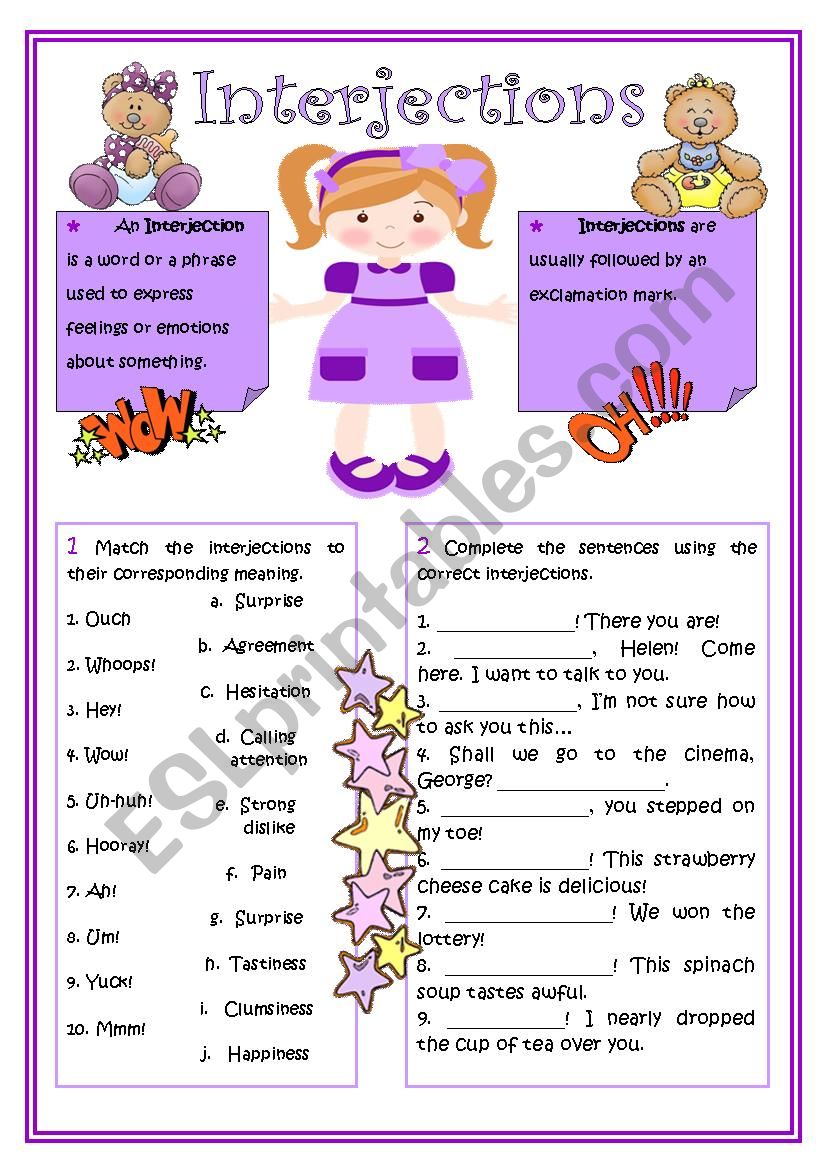
- Wow! That’s an amazing view. (Surprise, admiration)
- Ouch! I stubbed my toe. (Pain)
- Alas, the hero was defeated. (Sorrow, resignation)
- Bravo! You’ve done an excellent job. (Praise)
- Uh-oh, I think I left the stove on. (Alarm, realization of a mistake)
- Well, I suppose we could try that. (Hesitation, contemplation)

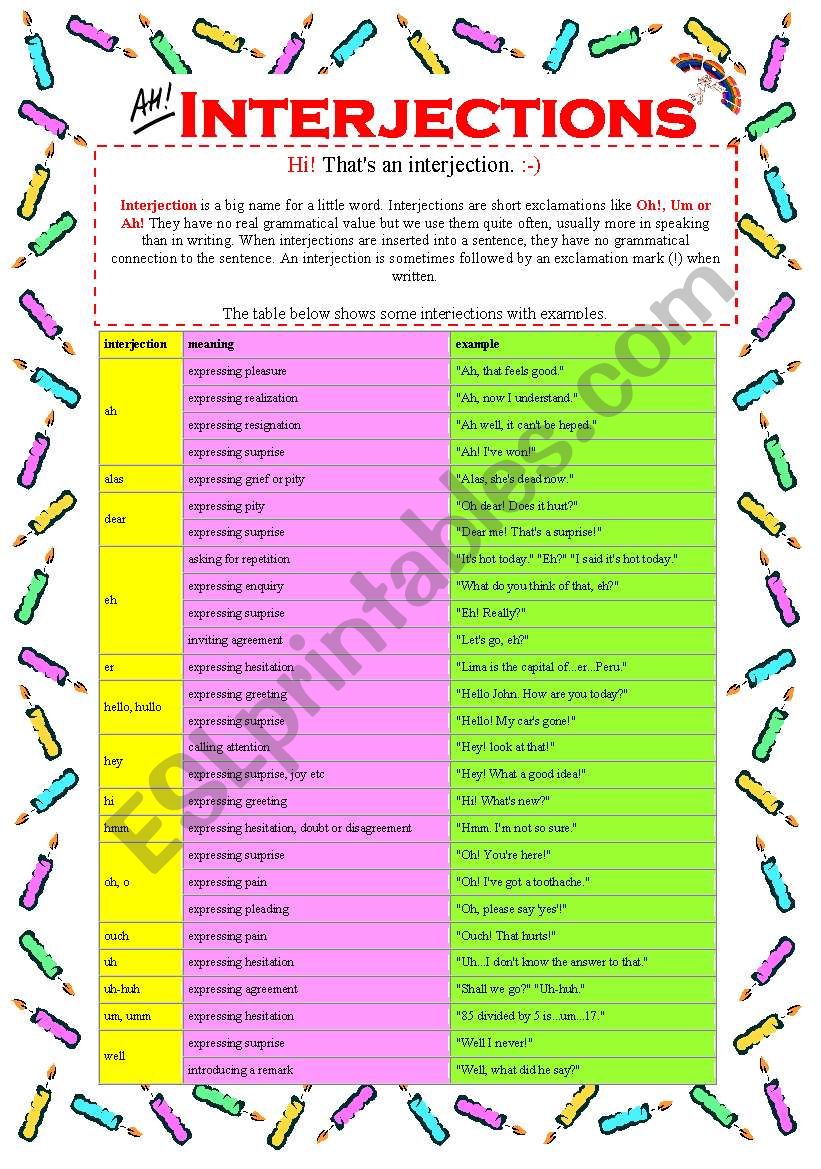

Interjections can be categorized loosely based on the emotion they convey:
- Expressions of Joy/Pleasure: Yay!, Hurray!, Yippee!, Bravo!
- Expressions of Pain/Discomfort: Ouch!, Ow!, Ugh!
- Expressions of Surprise/Astonishment: Wow!, Oh!, Ah!, Gosh!, What?!
- Expressions of Disgust/Annoyance: Ew!, Yuck!, Phooey!, Bah!
- Expressions of Agreement/Disagreement: Yes!, No!, Indeed!, Nope!
- Expressions of Hesitation/Thought: Um…, Er…, Well…
- Greetings/Farewells: Hello!, Goodbye!, Hey!, Bye!
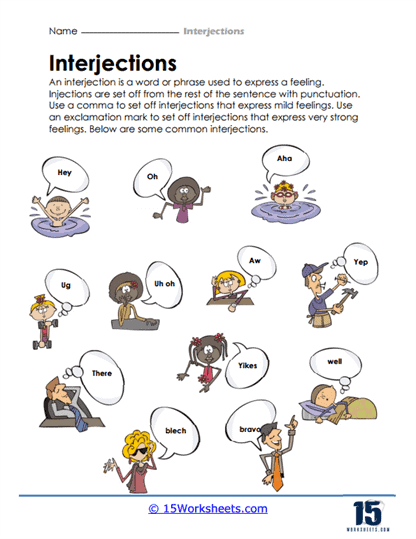

Punctuation is key when using interjections. Strong interjections, those expressing intense emotion, are often followed by an exclamation mark (!). Milder interjections, or those that blend more seamlessly with the sentence, might be followed by a comma (,). Sometimes, a very mild interjection might not need any punctuation if it’s integrated smoothly into a sentence, though this is less common for standalone interjections.
Why Interjections Matter: Beyond Grammar Rules
While they might seem like trivial add-ons, interjections play a vital role in communication for several reasons:
- Authenticity and Naturalness: They make spoken and written language sound more natural and authentic, mimicking real-life conversation patterns. Without them, dialogue can sound stiff and robotic.
- Emotional Conveyance: They are the most direct way to express immediate emotions. A simple "Ouch!" conveys pain far more succinctly and powerfully than "I am experiencing a sensation of discomfort."
- Nuance and Context: Interjections can provide crucial context to a statement. The difference between "Oh, you’re here" (mild surprise) and "Oh! You’re here!" (strong surprise, perhaps delight or shock) is entirely conveyed by the interjection and its punctuation.
- Conciseness: They allow for the quick and efficient communication of complex feelings.
- Relatability: Using interjections correctly helps speakers and writers connect with their audience on an emotional level.
For language learners, mastering interjections is a significant step towards achieving fluency. It moves them beyond merely constructing grammatically correct sentences to truly sounding like a native speaker, capable of expressing a full range of human emotions.
The Role of Worksheets in Grammar Acquisition
Worksheets have long been a staple of language education, and for good reason. They offer a structured environment for learners to:
- Practice actively: Moving beyond passive listening or reading to actively applying rules.
- Reinforce concepts: Repetition through varied exercises solidifies understanding.
- Identify gaps: Teachers and learners can pinpoint areas of weakness.
- Build confidence: Successfully completing tasks provides a sense of accomplishment.
- Provide immediate feedback: Often, worksheets come with answer keys, allowing for self-correction.
While digital tools and interactive apps are gaining popularity, the tangible nature of a worksheet, the act of writing, and the ability to review and annotate at one’s own pace remain invaluable.
The Unique Benefits of Interjections Worksheets
Given the distinct nature of interjections, specialized interjections worksheets are an invaluable resource for several specific reasons:
- Contextual Understanding: Interjections are heavily context-dependent. A worksheet can present various scenarios, prompting learners to choose the most appropriate interjection for a given situation. This moves beyond rote memorization to genuine comprehension of usage.
- Punctuation Practice: They provide focused exercises on correct punctuation (exclamation mark vs. comma), a common point of confusion.
- Differentiation from Other Parts of Speech: Learners often confuse interjections with adverbs or conjunctions that might appear at the beginning of a sentence. Worksheets can include exercises that require learners to identify only the interjection, or to differentiate it from other words.
- Vocabulary Expansion: Beyond common interjections, worksheets can introduce learners to a broader range, enriching their expressive lexicon.
- Application in Dialogue: Many worksheets encourage writing short dialogues or sentences, allowing learners to see how interjections integrate naturally into conversation.
- Targeted Skill Development: Unlike general grammar exercises, interjections worksheets specifically target the skill of emotional expression, which is often neglected in favor of more "structural" grammar points.
Types of Effective Interjections Worksheets
A comprehensive set of interjections worksheets should include a variety of exercise types to cater to different learning styles and reinforce concepts from multiple angles:
-
Identification Worksheets:
- Underline/Circle the Interjection: Simple exercises where learners identify interjections within sentences or paragraphs.
- True/False: Statements about interjections (e.g., "An interjection always needs an exclamation mark").
-
Matching Worksheets:
- Match Interjection to Emotion: Learners match an interjection (e.g., "Yippee!") to the emotion it conveys (e.g., "Joy").
- Match Interjection to Scenario: Learners match an interjection to a brief situation where it would be appropriate (e.g., "Oops!" to "when you make a small mistake").
-
Fill-in-the-Blank Worksheets:
- Choose the Best Interjection: Sentences with blanks where learners select from a word bank of interjections based on context.
- Open-Ended Fill-in-the-Blank: Learners spontaneously provide an appropriate interjection for a given sentence.
-
Sentence Construction Worksheets:
- Use the Interjection in a Sentence: Learners write original sentences incorporating specific interjections.
- Dialogue Writing: Prompts for short dialogues where learners must naturally include several interjections.
-
Punctuation Worksheets:
- Add Correct Punctuation: Sentences with interjections that require learners to add either an exclamation mark or a comma.
- Rewrite Sentences: Learners rewrite sentences to correctly incorporate and punctuate an interjection.
-
Categorization Worksheets:
- Sort Interjections by Emotion: Learners group interjections under headings like "Surprise," "Pain," "Disgust," etc.
-
Creative Writing Prompts:
- Story Starters: Begin a short story or paragraph that requires the use of several interjections to convey character emotion.
- Describing a Scene: Describe a vivid scene (e.g., a roller coaster ride, a scary movie) and use interjections to convey reactions.
When designing effective interjections worksheets, it’s crucial to ensure clear instructions, provide varied and engaging contexts, and offer an answer key for self-correction. Visual appeal, such as relevant images or clear formatting, can also enhance the learning experience.
Integrating Interjections Worksheets into Learning and Teaching
The versatility of interjections worksheets allows for their integration into various learning environments:
- In the Classroom:
- Warm-up activities: A quick worksheet to start a lesson on emotions or dialogue.
- Individual practice: Assign as homework or independent work.
- Pair/Group work: Learners collaborate to complete worksheets, fostering discussion and peer learning.
- Role-playing: After completing worksheets, learners can act out dialogues using the interjections they practiced.
- For Self-Study:
- Online resources: Many educational websites offer printable or interactive interjections worksheets.
- Workbooks: Dedicated grammar workbooks often include sections on interjections.
- Supplement to reading/listening: Learners can identify interjections in books, articles, or audio content, then use worksheets to reinforce their understanding.
- Before and After Writing Tasks:
- Before writing a narrative, use worksheets to brainstorm interjections that characters might use.
- After writing, use a worksheet as a checklist to ensure a variety of interjections have been used appropriately.
Beyond the Worksheet: Real-World Application
While interjections worksheets are a fantastic foundational tool, true mastery comes from applying the knowledge in real-world contexts. Encourage learners to:
- Listen actively: Pay attention to how native speakers use interjections in movies, TV shows, podcasts, and daily conversations.
- Read critically: Identify interjections in novels, short stories, and comics. Notice how authors use them to reveal character and advance plot.
- Speak spontaneously: Practice incorporating interjections into their own conversations, even if it feels awkward at first. Start with common ones like "Oh," "Wow," or "Ugh."
- Write expressively: Consciously add interjections to their creative writing, emails, and social media posts to convey genuine emotion.
Conclusion
Interjections, though small in stature, are mighty in their impact on language. They are the spontaneous, unvarnished expressions of human emotion that bring vibrancy and authenticity to our communication. For anyone seeking to truly master English, beyond mere grammatical correctness, understanding and appropriately using interjections is a non-negotiable skill.
Interjections worksheets serve as an indispensable bridge between theoretical knowledge and practical application. By providing structured, engaging, and varied exercises, they empower learners to identify, understand, and confidently deploy these powerful emotional cues. From basic identification to nuanced contextual usage and correct punctuation, these worksheets lay the groundwork for more natural speech and more vivid writing. Embrace the power of interjections, and let the journey begin with the targeted practice offered by well-crafted interjections worksheets. They are not just about learning words; they are about learning to express the full spectrum of human feeling.
